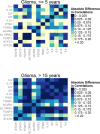Association between Prediagnostic Allergy-Related Serum Cytokines and Glioma
- PMID: 26352148
- PMCID: PMC4564184
- DOI: 10.1371/journal.pone.0137503
Association between Prediagnostic Allergy-Related Serum Cytokines and Glioma
Abstract
Allergy is inversely related to glioma risk. To determine whether prediagnostic allergy-related serum proteins are associated with glioma, we conducted a nested case-control study of seven cytokines (IL4, IL13, IL5, IL6, IL10, IFNG, TGFB2), two soluble cytokine receptors (sIL4RA, sIL13RA2) and three allergy-related transcription factors (FOXP3, STAT3, STAT6) using serum specimens from the Janus Serum Bank Cohort in Oslo, Norway. Blood donors subsequently diagnosed with glioma (n = 487) were matched to controls (n = 487) on age and date of blood draw and sex. We first estimated individual effects of the 12 serum proteins and then interactions between IL4 and IL13 and their receptors using conditional logistic regression. We next tested equality of case-control inter-correlations among the 12 serum proteins. We found that TGFB2 is inversely related to glioblastoma (Odds Ratio (OR) = 0.87, 95% Confidence Interval (CI)) = 0.76, 0.98). In addition, ≤ 5 years before diagnosis, we observed associations between IL4 (OR = 0.82, 95% CI = 0.66, 1.01), sIL4RA (OR = 0.80, 95% CI = 0.65, 1.00), their interaction (OR = 1.06, 95% CI = 1.01, 1.12) and glioblastoma. This interaction was apparent > 20 years before diagnosis (IL4-sIL4RA OR = 1.20, 95% CI = 1.05, 1.37). Findings for glioma were similar. Case correlations were different from control correlations stratified on time before diagnosis. Five years or less before diagnosis, correlations among case serum proteins were weaker than were those among controls. Our findings suggest that IL4 and sIL4RA reduce glioma risk long before diagnosis and early gliomagenesis affects circulating immune function proteins.
Conflict of interest statement
Figures




References
Publication types
MeSH terms
Substances
Grants and funding
LinkOut - more resources
Full Text Sources
Other Literature Sources
Medical
Research Materials
Miscellaneous

